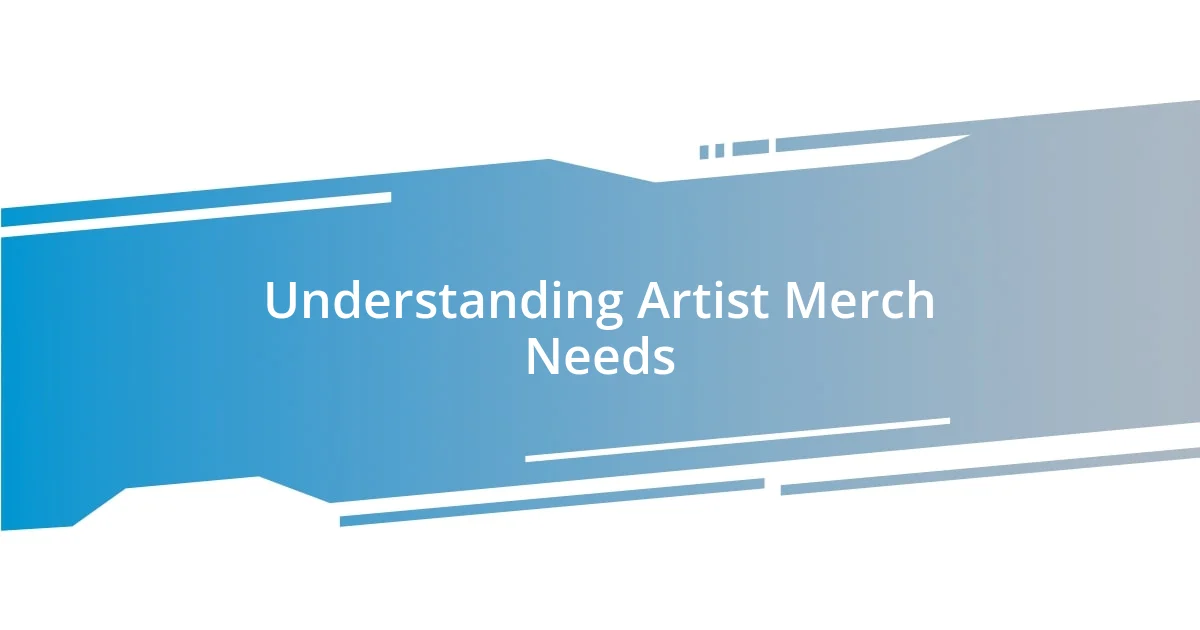Key takeaways:
- Understanding an artist’s unique identity and values is crucial for creating meaningful merchandise that resonates with their audience.
- Identifying target audiences through demographics, interests, and engagement helps customize merchandise effectively and fosters deeper connections.
- Building long-term relationships with artists through trust, transparency, and ongoing support enhances collaboration and contributes to their merchandise success.

Understanding Artist Merch Needs
Understanding the unique needs of artists when it comes to merchandise is crucial. I remember when an up-and-coming musician reached out, excited yet overwhelmed by the options. It struck me how important it was to provide not just products, but a true extension of their artistic identity.
The variety in merchandise can sometimes be mind-boggling—clothing, accessories, even limited-edition art prints. Have you ever considered how a simple T-shirt can resonate differently with fans? Each item can embody a piece of the artist’s essence, creating a deeper connection between them and their audience. I’ve seen artists flourish when their merch truly mirrors their style and message, creating a synergy that speaks volumes.
What resonates most with artists is understanding their brand’s story. For instance, one artist wanted to integrate eco-friendly materials into their merch. We brainstormed together and found a sustainable clothing line that not only aligned with their values but also excited their fans. It was a beautiful moment that illustrated how thoughtful choices can enhance both the artist’s reputation and their relationship with their audience.

Identifying Target Audiences
Identifying the right target audience is a pivotal step in creating effective merchandise that truly resonates. I recall a time when I assisted a visual artist in pinpointing her ideal fans. We dove into conversations about who connected with her work—were they young art students filling their walls with prints, or perhaps seasoned collectors with specific tastes? This exercise sparked a deeper understanding of her audience’s interests and buying behaviors, which ultimately shaped the types of products we developed.
To effectively identify target audiences, consider these key aspects:
- Demographics: Age, gender, and location can influence purchasing behavior.
- Interests: What hobbies or activities do fans engage in that complement the artist’s work?
- Engagement: How do fans interact with the artist? Through social media, live events, or other platforms?
- Feedback: Actively solicit input from fans through polls or discussions to understand their desires.
- Trends: Stay updated on market trends to see what merchandise resonates with similar audiences.
By focusing on these elements, I find you can not only discover who your audience is but also foster a more meaningful connection with them through merchandise that feels intentional and authentic.

Designing Unique Merchandise
When it comes to designing unique merchandise, collaboration with artists is key to capturing their essence. I recall working with a pottery artist who wanted to infuse her personal story into her designs. As we exchanged ideas, we discovered that her love for nature could inspire eco-themed pieces. This not only enhanced the uniqueness of her merchandise but also created a narrative that fans could connect with deeply.
Another aspect I find essential is the alignment of design elements with the artist’s brand. I had an experience with a band that had a distinctive retro vibe. Instead of typical band shirts, we opted for vintage-style jackets that reflected their identity while being stylish. Fans were thrilled by this unexpected twist, demonstrating how thinking outside the box can lead to memorable merchandise that stands apart from the crowd.
Additionally, I believe leveraging feedback from fans can lead to remarkable insights. One artist I supported launched a design contest, inviting fans to submit their ideas. The engagement was incredible, and many submissions became the foundation for future merchandise. This not only strengthened the bond between the artist and her supporters but also made the merchandise feel personal to the fans. How often do we see fans become part of the brand narrative? This approach transforms simple products into cherished memories.
| Aspect | Description |
|---|---|
| Collaboration | Working closely with artists to reflect their story and identity in merchandise design. |
| Design Alignment | Ensuring products align with the artist’s brand to create a compelling and cohesive look. |
| Fan Engagement | Gathering feedback and involving fans in the design process to create a deeper connection. |

Choosing Quality Materials
Choosing quality materials for merchandise is critical in making a lasting impression on fans. I once worked with a textile artist who was passionate about sustainability. We had numerous discussions about using organic cotton for her apparel line, highlighting its softness and eco-friendliness. The moment we decided on materials that aligned with her values, I felt the excitement in her voice—a tangible sign that the quality of the product could enhance her artistry.
It’s not just about aesthetics, though; the durability of the materials plays a significant role. I remember assisting a musician with a line of printed tote bags. We chose a thicker canvas over standard fabric because we wanted to ensure that these bags could withstand everyday use without fraying or fading. There’s something incredibly rewarding about seeing fans proudly carry merchandise that lasts—it’s a testament to the artist’s dedication and a reflection of their brand. Don’t you think fans appreciate quality more than anything else?
Ultimately, my experience tells me that choosing the right materials can elevate the entire merchandise experience. During a launch event for a jewelry artist, we opted for high-quality metals rather than cheaper alternatives. The moment her fans saw the shimmer and durability, their reactions were priceless. They could feel the artist’s commitment to quality! When fans recognize the craftsmanship behind a piece, it strengthens their connection to the artist and fosters loyalty.

Setting Up Online Stores
Setting up an online store is a crucial step in promoting an artist’s merchandise. From my experience, the first thing to consider is the platform that fits the artist’s needs. I’ve seen success with platforms like Shopify and Etsy because they provide user-friendly interfaces and customization options. Choosing the right one can make all the difference in how seamless the shopping experience feels for fans.
Once the platform is selected, I find that captivating product descriptions and high-quality images are essential. I remember a time when I worked with a sculptor who wanted to showcase her work online. We took the time to capture her sculptures from different angles, complemented by her heartfelt stories about each piece. The feedback from her fans was overwhelmingly positive; they felt a deeper connection to the items, almost as if they were getting a glimpse into the artist’s creative journey.
Another pivotal aspect is payment and shipping options. I often emphasize that customers appreciate flexibility and transparency. In one case, I guided a musician in offering multiple payment methods, including digital wallets. This small change improved the purchasing experience significantly. Isn’t it fascinating how simple adjustments can lead to better satisfaction for customers? When artists take this holistic approach to set up their stores, it not only enhances sales but fosters authenticity, ensuring fans feel valued.

Marketing Strategies for Merch
One effective marketing strategy for merchandise is leveraging social media platforms to connect with fans. I once collaborated with a band on a campaign that involved sneak peeks of their upcoming merch through Instagram Stories. We created buzz by teasing product designs leading up to the launch, which really ignited excitement. When fans feel included in the process, they’re much more likely to become eager buyers—don’t you think that feeling of anticipation drives engagement?
Email marketing is another powerful tool that artists can utilize. I remember helping a painter craft a message to her subscriber list, showcasing exclusive merch for her loyal supporters. We offered a limited-time discount, and the response was instant—sales poured in! This kind of targeted outreach not only generates excitement but also reinforces a sense of community. Have you seen how journeying together with fans through emails strengthens that bond?
Collaboration can elevate merch marketing not just for artists but for all involved. I once guided a textile designer to partner with a popular influencer. The influencer wore the gear in a live stream, showcasing its quality and style, which reached a wider audience. The results were staggering—sales skyrocketed, and new fans flooded in! Isn’t it intriguing how mutual promotion can amplify visibility and success? Exploring collaborations often yields surprising and rewarding outcomes in the world of merch.

Building Long Term Relationships
Building long-term relationships with artists is essential to the success of their merchandise. From my perspective, a genuine connection stems from understanding their vision and values. I recall working with a local band who were passionate about sustainability. By emphasizing eco-friendly materials in their merchandise, we created not just products but a shared ethos that resonated deeply with their fanbase. Isn’t it amazing how aligning values can foster a loyal community?
Trust plays a pivotal role in nurturing these relationships. I’ve often found that artists who have transparent communication about their sales and production processes see a marked increase in fan engagement. For instance, one artist I mentored openly shared the journey of their merch from concept to delivery through social media updates. Fans appreciated the behind-the-scenes access, which not only deepened their connection but also fostered a sense of loyalty. It’s like inviting them into your creative family, don’t you agree?
Finally, ongoing support is key. I believe in regularly checking in with artists, offering feedback and sharing insights into market trends. Once, I helped a musician who was feeling disheartened by stagnant sales. After analyzing their approach together, we refined their merch strategy and reignited their passion. Their subsequent comeback not only boosted sales but also revitalized their relationship with fans. Isn’t that the ultimate payoff—seeing an artist flourish while feeling supported every step of the way?
















